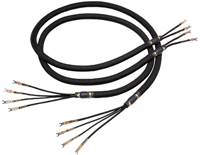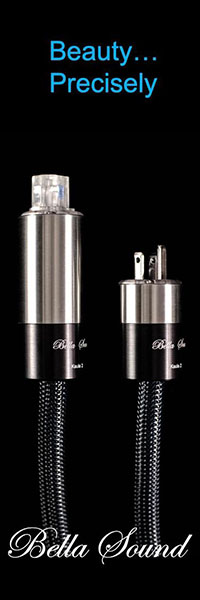Kimber BiFocal – XL Speaker Cable
| Kimber BiFocal – XL Speaker Cable |
|
A Clearer Vision? |
|
Adnan Arduman |
|
21 August 2001 |
 Specifications
Specifications
Price: $1,920 for an eight-foot pair
Manufacturer: KIMBER KABLE
2752 South 1900 West, Ogden, Utah 84401
Tel: 801.621.5530
Fax: 801.627.6980
Web: www.kimber.com
Support and technical questions:support@kimber.com
Product literature requests: info@kimber.com
I delayed the testing and reviewing processes for quite a while although the Kimber BiFocal – XL Speaker cables have been connected to my system for more than six months now. Such a long waiting time has an explanation that goes beyond pure laziness.
As the cable’s burn-in was getting near to its completion, I upgraded my digital front end with the wonderful Marantz SA-1. Of course, the new CD player also needed at least 300 hours of break in. It is relatively easy to break-in an interconnect or a digital cable as you don’t necessarily need to turn on your power amps. Just operate your CD player and/or your preamplifier and play a CD on “repeat” as long as you wish. In fact, I recommend that you play different complex music materials instead of a special break-in CD with designed signals. In the case of speaker cables, you need to physically play music through your speakers (which is not so tragic), but as I can’t play music continuously for 24 hours due to safety, tube life and noise constraints, the completion of minimum 300 hours break-in period took months.
Secondly, I prefer to write comparative reviews. My reference cable of many years is the Van den Hul Revelation. To be on the fair side, I thought that the Kimber cables needed at least 600 – 700 hours of break-in. I agree that after 300 hours you get marginal improvements, but margins are what we are after, isn’t it?
Unfortunately, the two cables don’t share the same price category. Even though the Kimber BiFocal – XL is nearly twice the price of the Van den Hul Revelation, I still needed a reference and the Van den Hul Revelation, being a classic in its category, was perfectly suitable for the job. For many years now they have kept their static position between my power amps and my speakers, fending off many other more expensive contenders that I tried. After all, we know that a higher price is not always an indication of a better sound.
Technical Information
As the name indicates, the cable is specifically designed to be used for “bi-wire” applications with speakers having independent binding posts for high and low frequencies. If this is not your case and you have either single or triple connections, then you would use either the Monocle – X or XL or the TriFocal – X or XL. Monocle, BiFocal and TriFocal are Kimber’s top three standard series speaker cables, just below the Select range.
BiFocal-XL uses twelve conductors for the inner, high frequency circuit and twenty-four conductors for the outer, low frequency circuit in a dual concentric format. Electrical isolation is accomplished by correlating circuit geometries with an isolating ESD matrix. The physical aspects can be summarized as follows:
-
Thirty-six discrete conductors
-
5.5awg / 15mm2
-
Hyper-pure copper
-
Varistrand geometry
-
X38R acoustic and electrostatic sinking core compound
-
Unique correlation circuit and alternating dielectric matrix
-
31mm diameter
-
Terminated with WBT spades or bananas
Similar in construction and technology to BiFocal-X, the BiFocal-XL is the heavier gauge version, using twice as many conductors (36 as opposed to 18).
I ordered my test sample terminated with spades on the amplifier side and with banana plugs on the speaker side. As my ProAc 3.8 speaker’s two pairs of binding posts are placed relatively close to each other, the use of banana plugs at that end offers much more convenience than spades. I also would like to draw your attention to their use of top quality terminators. They use WBT-0660 spades that have sandwich type construction with elastometer shock absorbers to allow progressive contact pressure and WBT-0645 banana plugs with additional plastic safety pins (to prevent children from sticking them into the mains) and expanding inner spikes for high contact pressure.
Listening and Comparing
I first chose just three or four CD’s with which I was going to carry out the comparative listening tests, but their diversity and number grew during the course of the listening session. Every CD had a specific test track that I listened to with both sets of cables in A-B-A fashion. More precisely, I first connected the Kimbers and listened to all the test tracks, then repeated the process with the Van den Huls and finally went back to Kimbers and listened one more time. Doing A-B-A testing gives you the chance to hear the differences when you pass from A to B, but it is possible to discern other nuances when you switch back from B to A.
Before telling you my impressions (and thus possibly to increase the suspense level), I will begin by giving you the list my evaluation CD’s:
Shostakovich Symphony 8, Concertgebouw/Haitink [Decca 411 616-2]
A legendary orchestra recording, I use it to discern dynamics, stage presentation, resolution and bass control performance.
Shostakovich Symphony 13 “Babi Yar”, Concertgebouw/Haitink [Decca 417 261-2]
An excellent recording for testing the resolution ability of massed vocals on male choir.
Cantate Domino by Motettkor, Nilsson, Linder, Mellnas [Proprius PRCD 7762]
Track 12 of this recording offers an organ that goes to very low frequencies, possibly down to 20 Hz. It is very good to assess the bass extension. In addition, the soprano voice is so liquid!
Saint-Saëns Symphony 3, “Organ”, BPO/Levine [DG 419 617-2]
This is another excellent recording for dynamics, tone color and orchestral resolution.
R. Strauss Violin Sonata E flat major, Op.18, Chung, Zimerman [DG 427 617-2]
A wonderful tool for timber evaluation of the two most difficult acoustic instruments: violin and piano. This is a real acid test!
Tracing Astor by Gidon Kremer [Nonesuch 79601-2]
This recording is outstanding for assessing violin tonality and inner detail.
Rickie Lee Jones’ It’s Like This [Artemis Records 751 054-2]
This is a great modern recording that allows you to test the purity and the sparkle of the triangles on the first track. In addition, there is Rickie Lee Jones’ lush voice!
VitalTechTones VTT2 [Tone Center TC-40082]
Here is an excellent recording of a fusion trio offering a beautiful electric bass tone for evaluation. This helps you to evaluate the roundness, definition and the tightness of this bass played by Victor Wooten. He is a real magician!
Keith Jarrett’s Bye, Bye Blackbird [ECM 1467]
Another classic trio recording that I have used for so long as a test CD that I could not skip this time.
Esbjorn Svensson Trio’s Good Morning Susie Soho [ACT 9009-2]
This is a beautiful modern recording of a Swedish jazz trio. What music! I used it to evaluate the cymbals and piano tonality, as well as bass control.
I will start by telling you that tonality wise, both cables sounded very correct and natural. The vdH was slightly darker and softer but both sounded very much alike as far as timber accuracy is concerned. In other words, neither showed any hint of coloration. That’s really a big plus for the two cables in question. For me, timbral accuracy has the highest level of priority: if any component fails there, I usually don’t go any further. I don’t care if the component has a great bass, staging or anything else if they add their own color to the music. An analogy may be a very high-resolution camera lens that adds pink color to everything photographed through it, as if using a permanent pink filter.
The similarities stop at this point though. The biggest difference lies in the area of soundstage presentation. While the vdH’s sound stage boundaries are the height and width of the two speakers with a little depth, the Kimber’s stage presentation goes well beyond the speakers. It is much deeper, higher and wider.
Many other differences seem to be the byproducts of this soundstage presentation handling. The Kimbers also offer more headroom, dynamics, air, effortless feeling, palpability and better-defined contours. The vdH’s weaknesses in such areas seem to be the result of their smaller soundstage. As the sound comes from a smaller area, it is more condensed and compressed. There is less air between instruments and consequently their ability to resolve inner detail is decreased. With the vdHs, crowded orchestral passages seem to be muddier and tiring, whereas the Kimber’s considerably bigger and deeper soundstage gives you the feeling of a more relaxed, effortless, cleaner and more see-through, sharper sound. Are attributes like headroom, dynamics, air and definition really the byproducts of the cables superior soundstaging abilities? I don’t know. I just had the feeling that they were.
However, the differences are not just limited to the soundstage and to its byproducts. I found the Kimber’s treble to have much more sparkle, detail and extension. It was cleaner and shinier. In addition, this extra polish and detail is not at all accompanied by nasty elements such as edginess, harshness and fatigue. In comparison, the vdHs seemed duller, muted and veiled.
Another very important difference was noticeable in the bass area. The Kimbers offer more extension and weight, which they readily revealed with the very low organ notes of the Cantate Domino. Track 12 of that recording is an excellent tool to test the extension of the low frequencies which they present crisper than the vdHs. I think that better controlled and extended bass also increases the feeling of the rhythm. In comparison, the vdH’s bass seemed looser and less defined. The better bass shaping (or definition) also helps the mids to be cleaner and more detailed. Overall, the vdHs sounded dull, lifeless, small, two-dimensional and consequently less involving then the Kimbers.
I may conclude my impressions with an analogy that seems very accurate to describe the differences between the two cables. Have you ever compared the two layers of a hybrid SACD disc? I suspect most of you have. What you hear when you switch from the CD layer to SACD is nearly the duplicate of what you notice when you switch from the Van den Hul Revelation to the Kimber BiFocal – XL. Between the two layers of a hybrid SACD there is nearly no tonal difference, but the SACD offers a better holographic presentation, more ambience, low-level detail, air, headroom, effortlessness and resolution. Although less subtle, the Kimber BiFocal – XL’s improvements were very similar. If you also consider the significant differences at both frequency extremes, I can easily state that the Kimber BiFocal – XL did more than SACD when compared with a very decent cable such as Van den Hul Revelation.
The Kimber BiFocal – XL is truly a great speaker cable. I decided to buy and keep them in my system. Since the BiFocal – XL is so devoid of any noticeable weakness, I wonder what the Select series of speaker cables will sound like. I really look forward to testing them one day.
![]()
Don’t forget to bookmark us! (CTRL-SHFT-D)
Stereo Times Masthead
Publisher/Founder
Clement Perry
Editor
Dave Thomas
Senior Editors
Frank Alles, Mike Girardi, Russell Lichter, Terry London, Moreno Mitchell, Paul Szabady, Bill Wells, Mike Wright, and Stephen Yan,
Current Contributors
David Abramson, Tim Barrall, Dave Allison, Ron Cook, Lewis Dardick, John Hoffman, Dan Secula, Don Shaulis, Greg Simmons, Eric Teh, Greg Voth, Richard Willie, Ed Van Winkle, Rob Dockery, Richard Doran, and Daveed Turek
Site Management Clement Perry
Ad Designer: Martin Perry





Be the first to comment on: Kimber BiFocal – XL Speaker Cable